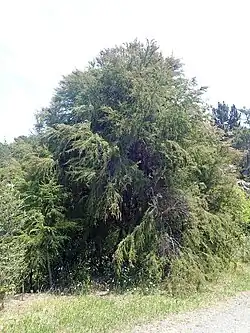Izatha balanophora
| Izatha balanophora | |
|---|---|

| |
| Scientific classification | |
| Kingdom: | Animalia |
| Phylum: | Arthropoda |
| Class: | Insecta |
| Order: | Lepidoptera |
| Family: | Oecophoridae |
| Genus: | Izatha |
| Species: | I. balanophora
|
| Binomial name | |
| Izatha balanophora (Meyrick, 1897)
| |
| Synonyms[1] | |
| |
Izatha balanophora is a moth of the family Oecophoridae. It is endemic to New Zealand, where it is widespread in the North Island. Larvae live off the dead bark of kānuka. The adult moths are on the wing during December to March. This species only occasionally comes to light.
Taxonomy
This species was first described by Edward Meyrick in 1897 using a specimen collected by George Hudson in Wellington and named Semiocosma balanophora.[2][1] The holotype specimen is held at the Natural History Museum, London.[1] Meyrick placed this species in the genus Izatha in 1915.[3] Alfred Philpott, thinking he was describing a new species, named the moth Izatha milligani in 1927.[4] The holotype specimen Philpott used is held at the New Zealand Arthropod Collection.[5] This name was synonymised by George Hudson when he discussed and illustrated this species in 1939.[6]
Description
.jpg)
Meyrick described the species as follows:
♂ 21 mm. Head and thorax white, with a few dark fuscous scales, shoulders narrowly dark fuscous. Palpi white, basal half and a subapical ring of second joint, and median baud of terminal joint dark fuscous. Forewings elongate, moderate, costa moderately arched, apex obtuse, termen obliquely rounded; white, with a few fuscous and dark fuscous scales; elongate dark fuscous marks along costa at base, before middle, and beyond middle; stigmata fuscous mixed with black, plical obliquely before first discal, a minute black dot between first and second discal; obscure indications of an angulated fuscous shade before termen; a terminal series of undefined dark fuscous dots: cilia whitish sprinkled with fuscous. Hindwings whitish-fuscous.[2]
The wingspan is 19.5–27 mm for males and 23.5–31 mm for females. Pale specimens of I. balanophora can be confused with I. blepharidota however I. balanophora always has a wider an elongate dark patch along the forewing costa in comparison the narrow dash of I. blepharidota.[5] This species could also be confused with weakly marked I. mesoschista and I. haumu but it lacks the curved black line in the forewing disc of the other two species.[5]
Distribution
This species is endemic to New Zealand.[7][8] I. balanophora is widespread through the North Island but is regarded as uncommon.[5] The species is likely under recorded.[5] It has been recorded Northland, Auckland, Waikato, Taranaki, Taupo, Rangitikei and Wellington districts.[5] Although Hudson gave records of specimens from the South Island Robert J. B. Hoare hypothesised that these are likely I. manubriata.[5]
Biology and behaviour
Adults are on wing from December to March.[5] This species occasionally comes to light.[5]
Habitat and hosts

Larvae have been reared from dead Kunzea ericoides and from an unidentified rotten log on the ground.[9]
References
- ^ a b c Dugdale , J. S. (23 September 1988). "Lepidoptera - annotated catalogue, and keys to family-group taxa". Fauna of New Zealand. 14. Department of Scientific and Industrial Research: 94. doi:10.7931/J2/FNZ.14. ISSN 0111-5383. Wikidata Q45083134.
- ^ a b Edward Meyrick (16 December 1897). "XVI. Descriptions of New Lepidoptera from Australia and New Zealand". Transactions of the Royal Entomological Society of London. 45 (4): 389. doi:10.1111/J.1365-2311.1897.TB00976.X. ISSN 0035-8894. Wikidata Q56158835.BHL page 14683290
 This article incorporates text from this source, which is in the public domain.
This article incorporates text from this source, which is in the public domain.
- ^ E. Meyrick (12 July 1915). "Revision of New Zealand Tineina". Transactions and Proceedings of the New Zealand Institute. 47: 215. ISSN 1176-6158. Wikidata Q63123349.BHL page 3343209
 This article incorporates text from this source, which is in the public domain.
This article incorporates text from this source, which is in the public domain.
- ^ Philpott, Alfred (4 August 1927). "Notes and Descriptions of New Zealand Lepidoptera". Transactions and Proceedings of the Royal Society of New Zealand. 58: 80–90 – via PapersPast.
- ^ a b c d e f g h i Hoare, Robert R. J. (2 September 2010). "Izatha (Insecta: Lepidoptera: Gelechioidea: Oecophoridae)" (PDF). Fauna of New Zealand. 65. Lincoln, Canterbury, New Zealand: Landcare Research New Zealand Ltd: 1–201. ISSN 1179-7193. Archived from the original (PDF) on 26 January 2019. Retrieved 16 April 2019.
- ^ Hudson, G. V. (1939). A supplement to the butterflies and moths of New Zealand. Wellington: Ferguson & Osborn Ltd. p. 448. OCLC 221041540. Retrieved 16 April 2019.
- ^ Gordon, Dennis P., ed. (2010). New Zealand inventory of biodiversity: Kingdom animalia: chaetognatha, ecdysozoa, ichnofossils. Vol. 2. p. 462. ISBN 978-1-877257-93-3. OCLC 973607714. OL 25288394M. Wikidata Q45922947.
- ^ "Izatha balanophora (Meyrick, 1897)". www.nzor.org.nz. Manaaki Whenua Landcare Research. Retrieved 16 April 2019.
- ^ "Herbivore Report Assessment". plant-synz.landcareresearch.co.nz. Manaaki Whenua Landcare Research. Retrieved 16 April 2019.